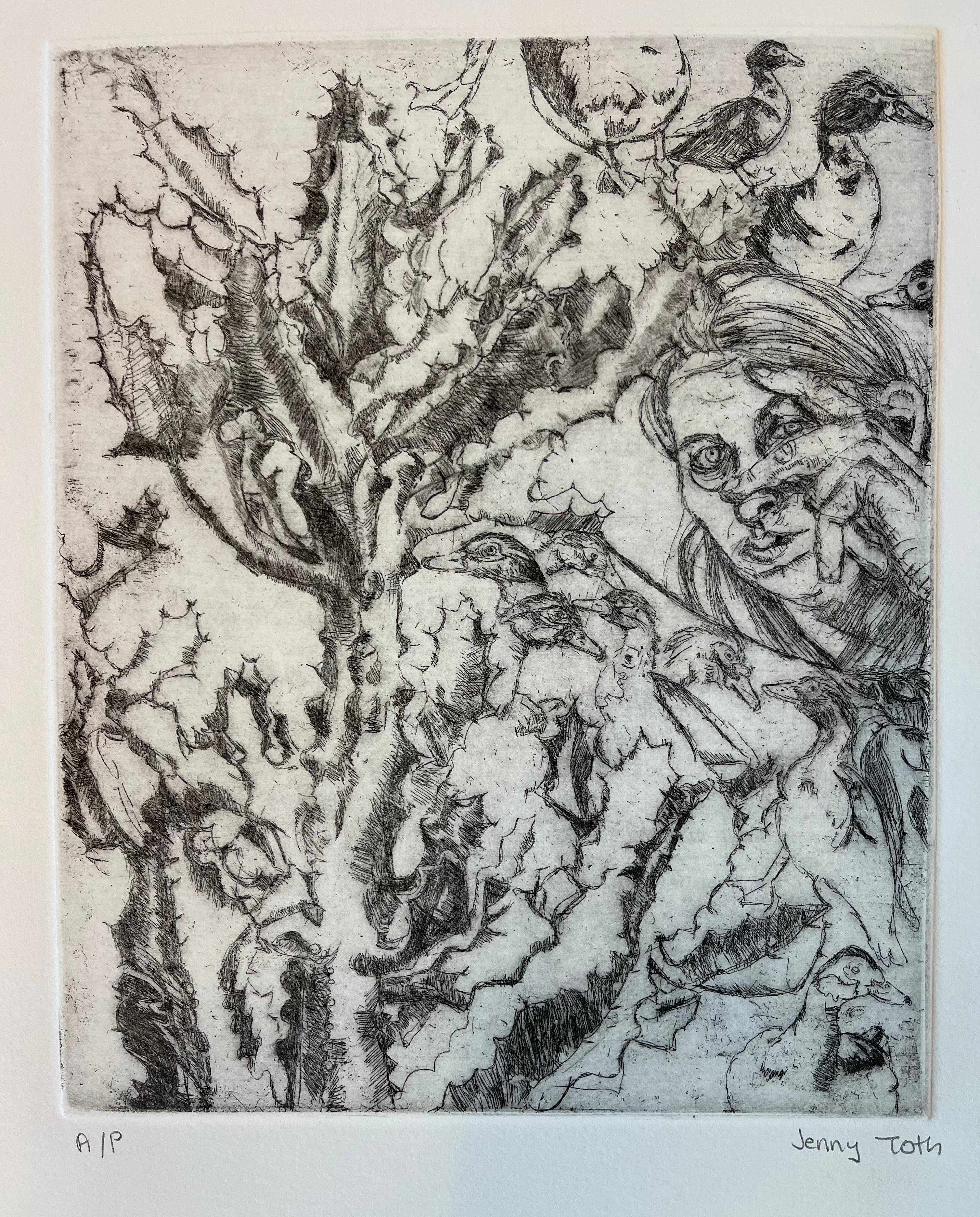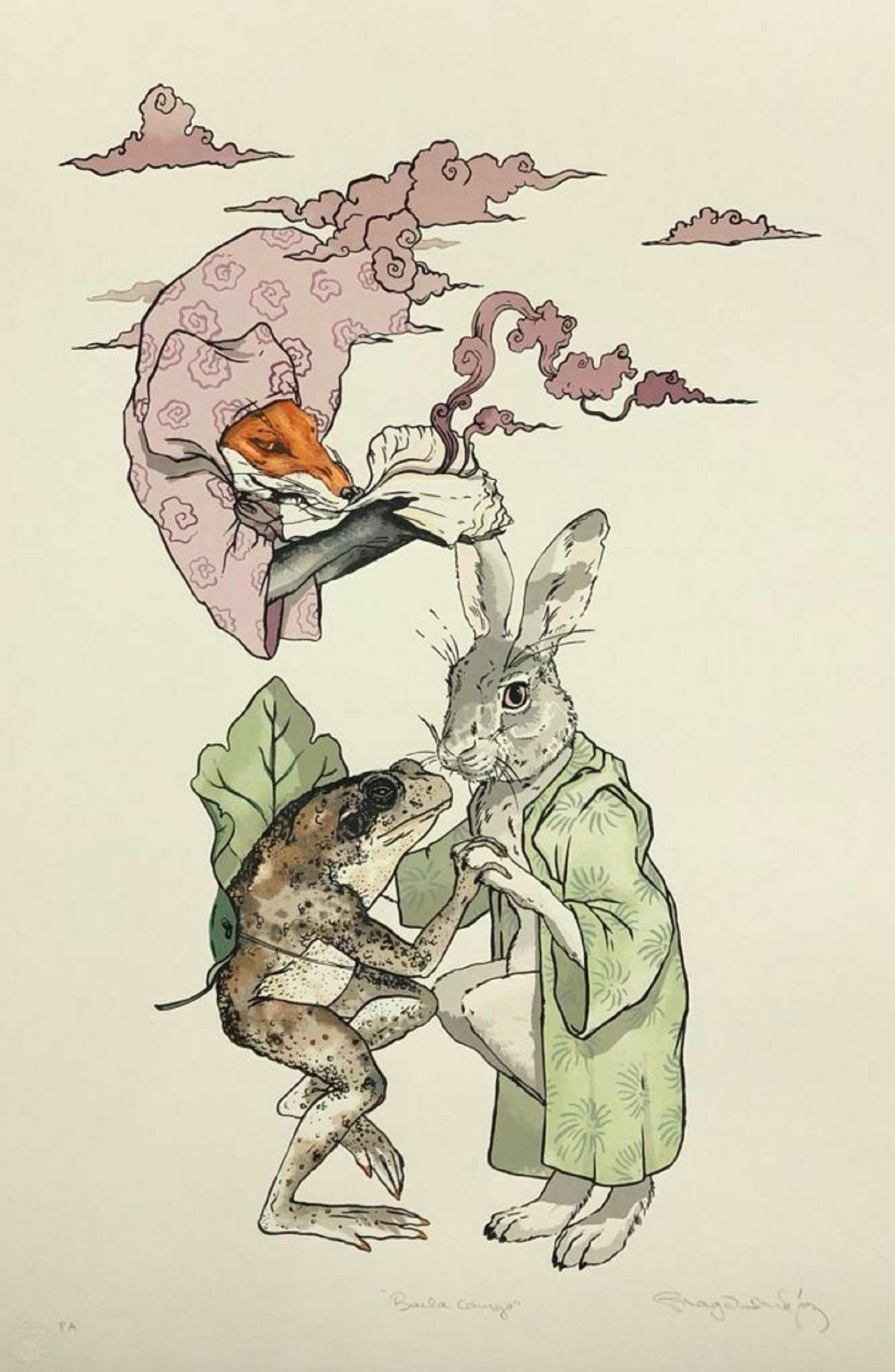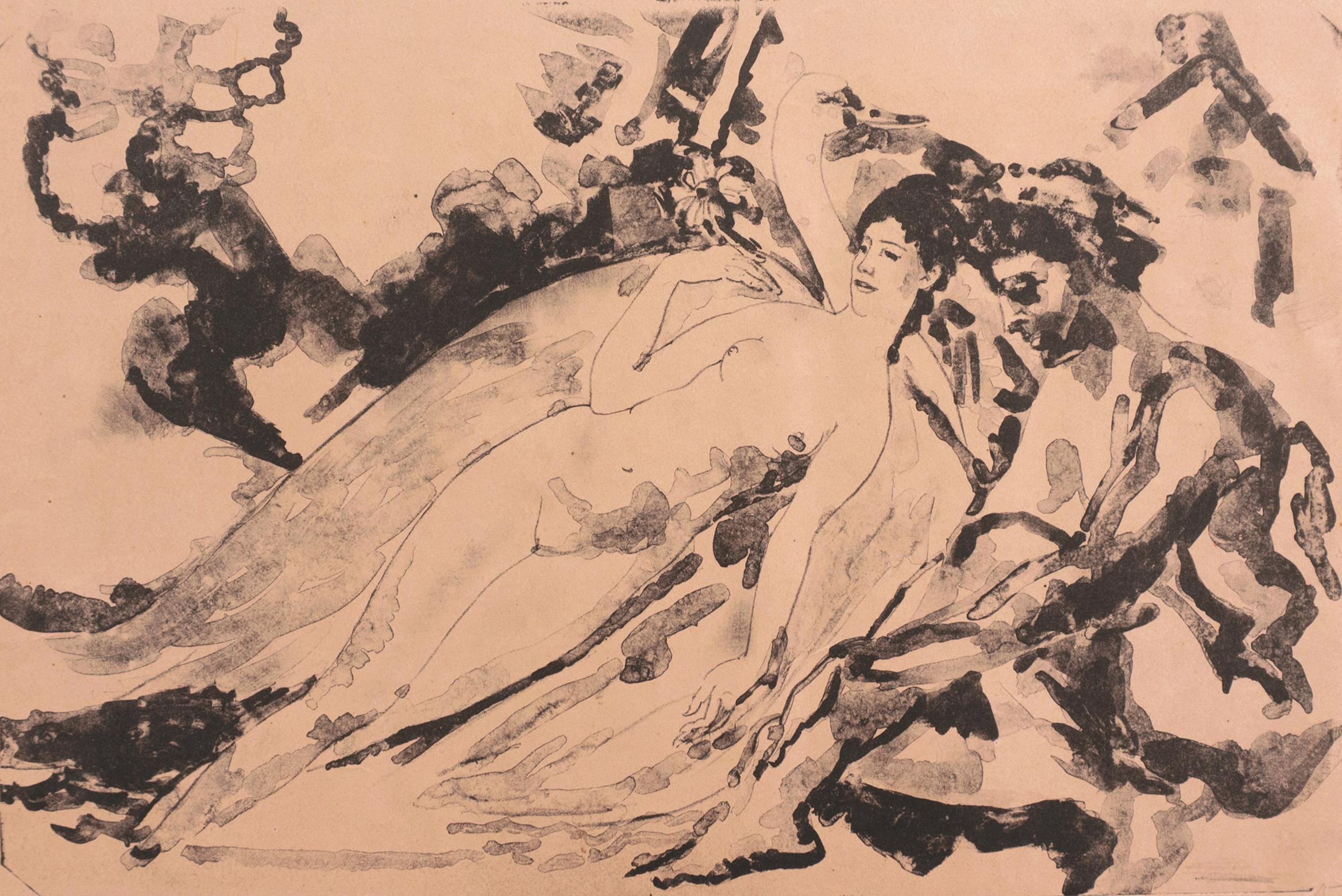Items Similar to Art Deco Etching and Aquatint "Jeunesse" Original Signed by Louis Icart
Want more images or videos?
Request additional images or videos from the seller
1 of 12
Louis IcartArt Deco Etching and Aquatint "Jeunesse" Original Signed by Louis Icart1930
1930
About the Item
Art Deco Etching and Aquatint "Jeunesse" (Youth) Signed by Louis Icart
Iconic figurative of woman and horse titled "Jeunesse" (Youth) by famous Art Deco artist Louis Icart (French, 1890 - 1950), 1930. Classically art deco in style and vibe, a young woman (most likely is Icart's wife and muse Fanny Volmers) is on wind-swept grassy knoll with powerful black stallion creating an intriguing juxtaposition of delicate beauty with animal strength.
Signed: below image lower right in pencil, embossed monogram lower left
Dated: On verso "copyright 1930 by Louis Icart, Paris"
Medium: Etching on paper, aquatint
Presented in original patinated, octagon shaped antique frame; new acid-free mat.
Paper size: 30"H x 21.25"W
Image size: 24"H x 15.50"W
Louis Justin Laurent Icart was born in Toulouse in 1890 and died in Paris in 1950. He lived in New York City in the 1920s, where he became known for his Art-Deco color etchings of glamourous women. He was first son of Jean and Elisabeth Icart and was officially named Louis Justin Laurent Icart. The use of his initials L.I. would be sufficient in this household. Therefore, from the moment of his birth he was dubbed 'Helli'. The Icart family lived modestly in a small brick home on rue Traversière-de-la-balance, in the culturally rich Southern French city of Toulouse, which was the home of many prominent writers and artists, the most famous being Henri de Toulouse-Lautrec.
Icart entered the l'Ecole Superieure de Commerce de Toulouse in order to continue his studies for a career in business, particularly banking (his father's profession). However, he soon discovered the play writings of Victor Hugo (1802-1885), which were to change the course of his life. Icart borrowed whatever books he could find by Hugo at the Toulouse library, devouring the tales, rich in both romantic imagery and the dilemmas of the human condition. It was through Icart's love of the theater that he developed a taste for all the arts, though the urge to paint was not as yet as strong for him as the urge to act.
It was not until his move to Paris in 1907 that Icart would concentrate on painting, drawing and the production of countless beautiful etchings, which have served (more than the other mediums) to indelibly preserve his name in twentieth century art history.
In 1914 Icart had met an effervescent eighteen-year-old blonde named Fanny Volmers, at the time an employee of the fashion house Paquin. She would eventually become his wife and a source of artistic inspiration for the rest of his life.
Art Deco, a term coined at the 1925 Paris Exposition des Arts Decoratifs, had taken its grip on the Paris of the 1920s. By the late 1920s Icart, working for both publications and major fashion and design studios, had become very successful, both artistically and financially. His etchings reached their height of brilliance in this era of Art Deco, and Icart had become the symbol of the epoch. Yet, although Icart has created for us a picture of Paris and New York life in the 1920s and 1930s, he worked in his own style, derived principally from the study of eighteenth-century French masters such as Jean Antoine Watteau, François Boucher and Jean Honoré Fragonard.
Art Deco was a period of perfection of workmanship, and in this Icart's art is tied closely to the period. He was an expert craftsman and aimed for perfection in his etching technique. Art Deco was also a smart and sophisticated style, and Icart surrounded himself with rich materials, fine furniture, Chinese lacquer screens, and other luxuries. This refinement of taste and the luxury with which he lived also linked him to the opulent spirit of the times. Fashions were undergoing major transition. Women were eager to divest themselves of the heavy overflow of lace, cotton, buckles, and high necklines worn by their mothers. New trends called for higher waistlines, and for clothing that clung to the body rather than billowing out. Icart reflected such fashion changes in, for example, his famous and inimitable illustrations for the magazine Luxe de Paris.
- Creator:Louis Icart (1888 - 1950, French)
- Creation Year:1930
- Dimensions:Height: 33 in (83.82 cm)Width: 24 in (60.96 cm)Depth: 0.75 in (1.91 cm)
- Medium:
- Movement & Style:
- Period:
- Condition:Good; tonal age and minor foxing consistent with age and wear. Original mat (see image) replaced with new acid-free mat. Original frame in good condition and included as-is.
- Gallery Location:Soquel, CA
- Reference Number:
About the Seller
5.0
Platinum Seller
These expertly vetted sellers are 1stDibs' most experienced sellers and are rated highest by our customers.
Established in 1986
1stDibs seller since 2014
2,515 sales on 1stDibs
Typical response time: <1 hour
- ShippingRetrieving quote...Ships From: Soquel, CA
- Return PolicyA return for this item may be initiated within 14 days of delivery.
More From This SellerView All
- "Nohubo remedio" (There was no remedy) - Etching and Aquatint on PaperBy Francisco GoyaLocated in Soquel, CA"Nohubo remedio" (There was no remedy) - Etching and Aquatint on Paper Bold 3rd or 4th edition, circa 1868-1878, with burnished aquatints, drypoints etching, and engravings by Franc...Category
1790s Old Masters Figurative Prints
MaterialsEngraving, Paper, Etching, Aquatint
- 1970's Figurative Home Interior Etching, Portrait of a Couple with DogsLocated in Soquel, CA1970's modernist etching of a man and woman at home with their dogs by Stephen Martin (American, 20th Century). The enigmatic couple both wear sungla...Category
1970s Contemporary Figurative Prints
MaterialsPaper, Ink, Etching
- Conversations at the Bar - Figurative Animal EtchingLocated in Soquel, CA1970's modernist anthropomorphic animals at a bar by Stephen Martin (American, 20th Century). Several animals sit at a bar, with a few in the b...Category
1970s Contemporary Figurative Prints
MaterialsPaper, Ink, Etching
- "Horses", 1960's Pop Art Etching A/PBy Marc Foster GrantLocated in Soquel, CAA late 1960's modern Pop Art etching of horses by Marc Foster Grant (American, b.1947). The galloping horse motif is repeated, in the style of Warhol...Category
1960s Pop Art Animal Prints
MaterialsPrinter's Ink, Etching, Paper
- "The Engraver" Double Layer Woodblock PrintLocated in Soquel, CABold woodcut print by M. Sheppard (20th Century). This piece is filled with Neolithic imagery of people and animals. There are two figures that are engaged in hunting and several pre...Category
1980s Other Art Style Figurative Prints
MaterialsPaper, Ink, Woodcut
- Rein Og Pulk (Reindeer and Sleighs) - Laplander Sami in his PulkBy Yuri MotLocated in Soquel, CAJoyful image of a woodcut print of a Reindeer pulling a Laplander Sami in his Pulk (small toboggan), a traditional scene in Lapland folklore and history by Yuri Mot. Signed indistinc...Category
1970s Folk Art Figurative Prints
MaterialsWoodcut, Laid Paper
You May Also Like
- Finger Parrot, monochromatic print bold graphic, surreal bird, handsBy Jenny TothLocated in Brooklyn, NYThis is an artist proof (one of a kind) aquatint of a parrot made up of fingers, and beautiful insects cascading to her right. She has a human ear on one side. The images is 6 x 6 ...Category
2010s Contemporary Figurative Prints
MaterialsPaper, Ink, Archival Ink, Aquatint
- Ducks Quacking, Cactus Peeking, linear style, monochromaticBy Jenny TothLocated in Brooklyn, NYThis is an artist proof aquatint of a woman peeking around a cactus with ducks mysteriously hovering in the upper right corner and a giant beautiful cactus overgrowing. The mood is ...Category
2010s Expressionist Figurative Prints
MaterialsPaper, Ink, Archival Ink, Aquatint
- Mariana Magdaleno, ¨Baila conmigo¨, 2018, Silkscreen, 29.3x21.3 inLocated in Miami, FLMariana Magdaleno (Mexico, 1982) 'Baila conmigo', 2018 silkscreen on paper Feltmark 300 g 29.4 x 21.3 in. (74.5 x 54 cm.) Edition of 50 ID: MAM-101 UnframedCategory
2010s Contemporary Animal Prints
MaterialsPaper, Ink, Etching, Aquatint, Screen
- 'Lida & the Swan', New York Armory Show, Ashcan School, ASL, NYMOMA, AIC, LACMABy Arthur B. DaviesLocated in Santa Cruz, CASigned lower right, 'Arthur B. Davies' for Arthur Bowen Davies (American, 1862-1928) and created circa 1915. An early twentieth-century sugar-lift aquatint showing Zeus in the guise of a swan, reclining and cradling Lida in his wings while King Tyndareus ponders the mutability of human circumstance. Born in Utica, New York, Arthur Davies attended the Chicago Academy of Design from 1879 to 1882. He furthered his studies at the Chicago Art Institute, before moving to New York City in 1885 where he studied at the Art Students League and Gotham Art Students League. In 1893, he made the first of many trips to Europe, visiting Holland, Paris, and London. He became an arch-exponent of Modernism and the central organizing figure of 1913's watershed Armory Show. Davies developed a style that combined visionary Symbolism with elements of Tonalism and Cubism. Who Was Who in American Art describes him as an “…important but enigmatic Modernist whose work was poetic, mysterious, and visionary”. Davies was the recipient of many gold medals and prizes and juried awards and his work is held in the permanent collections of museums nationwide, including New York’s Museum of Modern Art, the Art Institute of Chicago, the Baltimore Museum of Art and the Los Angeles County Museum of Art, among others. Photo of Arthur B Davies circa 1907 in New York City by Gertrude Käsebier courtesy of Library of Congress Prints and Photographs Division Washington, D.C. Reference: Who Was Who in American Art 1564-1975: 400 Years of Artists in America, Peter Hastings Falk, Sound View Press 1999, Vol. 1, p. 835; Artists in California 1786-1940, Third Edition, Edan Milton Hughes: Crocker Art Museum, Sheridan Books 2002, Vol. 1, p. 280; Thieme-Becker Allgemeines Lexikon der Bildenden Künstler von der Antike bis zu Gengenwart, Ulrich Thieme and Felix Becker, Deutscher Taschenbuch Verlag 1992, Vol. 7/8, p. 470; E. Benezit, Dictionnaire des Peintres, Sculpteurs, Dessinateurs, et Graveurs, Jacques Busse, 1999 Nouvelle Édition, Gründ 1911, Vol. 4, p. 293; Davenport’s Art Reference and Price Guide 2009/10 Edition, LTB Gordonsart, Inc. 2008, p. 672; et al. Additional biographical information follows, written by Catherine Southwick and Robert Torchia from the National Gallery of Art Online Editions: Arthur B. Davies’s mystical, mysterious paintings hearken back to 19th-century romanticism, even while Davies aligned himself with American artists advancing the most radical ideals of their day. Davies was born on September 26, 1862, in Utica, New York, the son of English and Welsh parents who had immigrated to the United States in 1856. He first took art lessons as a teenager from a local landscape painter, Dwight Williams...Category
Early 1900s Modern Figurative Prints
MaterialsAquatint, Paper
- PEINTRE AU TRAVAIL (BLOCH 1157)By Pablo PicassoLocated in Aventura, FLEtching, aquatint, drypoint and scraper, on Rives BFK paper. Hand signed and numbered by Pablo Picasso. Published by Galerie Louise Leiris, Paris. Image size 12.125 x 18.125 inches. ...Category
1930s Cubist Animal Prints
MaterialsDrypoint, Paper, Aquatint, Engraving
- Owl and Pussycat and Blue Cat Fest diptychLocated in Deddington, GBOverall size- H71 x W71 Owl and Pussycat by Rebecca Denton [2019] limited_edition Etching and aquatint Edition number /40 Image size: H:25 cm x W:25 c...Category
21st Century and Contemporary Contemporary Animal Prints
MaterialsAquatint, Paper, Etching




